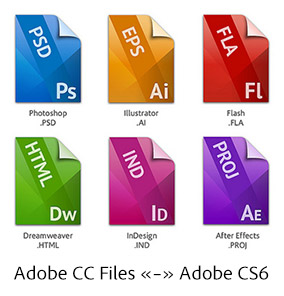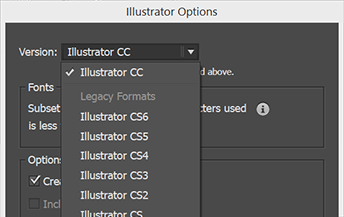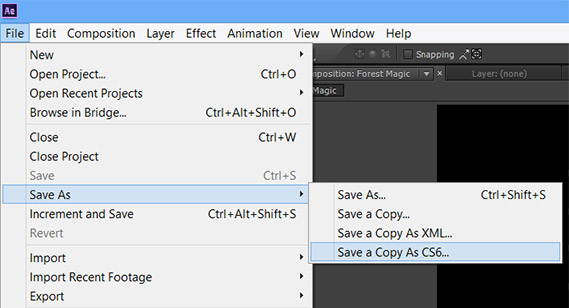Should I Upgrade To Photoshop Cc From Cs6 Now
Now that the Adobe CC release has become ubiquitous with over 26 meg paid customers, some folks are asking u.s.a. whether the new versions of the tools in the Creative Deject can read or save older data/certificate/project file formats like CS6, CS5.5, CS5, CS4 & CS3…

In fact, since Adobe's flagship creative toolset CC 2019 is now 7 major releases past CS6 from 2012 (which they no longer sell), file version compatibility tin can sometimes be an important conclusion signal in moving forrard.
In the past, new Adobe product versions have often brought different or expanded file formats to support significant new features – and customers desire to know if their existing projects will easily bear forrard with them when they upgrade, or if they volition be able to salve back to older formats for coworkers or clients who may nonetheless exist running an before revision of the programs…
OK then, here's how it works. Generally, your new CC tools volition exist able to open up and employ any and all earlier CS project and data files – including CS3, CS4, CS5, CS5.5, and CS6 files – with no problem or loss of information. In other words, all Adobe software is able to read or import file formats from previous versions of the same plan – and it should happen seamlessly and automatically. The only exception to this is Premiere Pro, where it'southward all-time to open up/edit projects in the same versions that created them.
Going the other way, when wanting to apply CS6 or older tools to open up a file saved from a CC product, the answer is information technology depends… Adobe officially states, "Many of the Artistic Cloud desktop applications can export files to the older Creative Suite half dozen version of the same tool. Each of the following CC apps provide the ability to export to the CS6 version of the program: Photoshop, InDesign, Illustrator, Breathing (previously called Flash Professional), and After Effects" – with the caveat that, "New features added may not exist supported in the exported file or implemented by the CS6 application." And the aforementioned would get for CS5, CS4, or CS3.
So let's take a closer look beneath at the interoperability for each major CC 2019 application inside the Creative Cloud, then at the bottom we'll talk about some additional tips and best practices no thing what the circumstance.
Special: Legally download dozens of free Adobe books for a express time!
Photoshop
Historically in Photoshop, it has rarely been an issue because the .PSD format is pretty portable and uniform (forwards and backwards) between unlike releases. To assistance ensure this, make certain that Photoshop's "Maximize PSD File Compatibility" option is turned on when you save your file.
With that in place, you should be able to save back your Photoshop CC file to be opened in CS6, or even lower versions (equally this sit-in of moving from CC to CS5 shows)… You can fifty-fifty brand changes to a CC file in an older release of Photoshop, and then after bring it back into CC with everything nowadays, active, and intact.
In fact, many people don't realize it but Photoshop's common file format specification is openly published and then that other tools can read, view, or save .PSD files, even 3rd-party software (for example, free utilities like XnView or CloudConvert)… Merely if you ever run into any difficulties, y'all can ever save your paradigm as a .tif file – TIFF is a universal 16-bit format that all versions of Photoshop (and many other programs) tin import, and its biggest reward is that information technology will preserve layers, but as the native .PSD file tin.
Since CS6, Photoshop CC streamlines your life when moving effectually between different computers with the Preset Migration feature. Upgrading or changing releases is also easier cheers to this new adequacy to share and migrate presets from older Photoshop versions going as far back as CS3.
Illustrator

In Illustrator it's very straightforward – when using "Salve Equally…", the program volition enquire which version you want to save your file equally. Instead of "Illustrator CC," y'all can choose a "Legacy Format" like "Illustrator CS6," CS5, CS4, CS3, etc. – just be aware that you may lose some newer features and attributes when the document is read back into the prior release. Illustrator actually has the all-time backsave capability of all tools every bit information technology can save down up to eleven previous formats!
There are also some other techniques available that may allow you to open files created in a newer version of Illustrator without backsaving.
InDesign
Each major new release of InDesign has e'er made a new format that older releases cannot open. The document file format evolves and improves with each successive version.
And with InDesign, there is no automated way to "downsave" a project like in Illustrator, and at that place never has been… But what yous can exercise instead is Export your document as IDML (InDesign Markup Language). IDML files can be read into earlier versions similar InDesign CS6, CS5.5, CS5, or CS4 – merely over again there is the potential to lose newer features that aren't supported in legacy releases. To get dorsum to InDesign CS3 you lot would demand to Export to INX (InDesign Interchange format) from CS4 instead.
Seeing the demand, Adobe created the Simple Saveback service, which is a free spider web service for Artistic Cloud subscribers to do this IDML file conversion on need. For instance, if you open a document saved from CC 2018 in the InDesign CC 2015 application, so you'll receive a dialog box with this detect:
InDesign could not open "filename.indd" considering it has been created in a newer version – Adobe InDesign CC 13.0. Click "Convert" to convert and open up this document.
Content created using features specific to the afterwards version of InDesign may be modified or omitted when you open up the document in a previous version.
<Convert> or <Cancel>
Alternatively, you can apply external file downsaving services which volition do this for you for a nominal fee – going from InDesign CC 2019 to CC 2018, CC 2017, CC 2015, CC 2014, CC 2013, CS6, CS5.5, CS5, CS4, CS3, CS2, or fifty-fifty CS[ane]. In that location'due south also a file conversion plugin available that enables lower versions of the InDesign application (such equally CS5 and CS5.five) to open all native .INDD documents that accept been saved past newer releases like CC [2018] or CS6.
Dreamweaver
In Dreamweaver, file compatibility with older versions is not really a trouble… HTML is HTML, CSS is CSS – the output is standards-based and similar across product releases. The ane office that you lot'd demand to drift forward or dorsum to a dissimilar version is your Dreamweaver site settings or definitions, and those you lot can easily import and export.
Animate (formerly Flash Pro)
Breathing CC was rearchitected for high functioning on 64-bit systems and completely rewritten to incorporate native HTML5 Canvas and WebGL support, and consequently some older features were deprecated. This means when you open a file previously saved with an before version of Flash Pro, you may run across a characteristic that is no longer supported in Animate CC 2019. The software volition bear witness a warning to this effect and automatically convert the deprecated content into a supported content type.
When going the other direction and bringing a CC file back to an lower release, Animate is pretty flexible – you can save in XFL or FLA format for CS6 or CS5.five, although you may lose some newer features which would non exist understood by prior versions. Additionally, Flash Professional person CS6 can relieve back to CS5 formats, and CS5 versions can downsave to CS4 formats.
Premiere Pro
Premiere Pro CC does not have a salvage-back-to-one-time-version option, and in fact the .prproj file format had a major alter from CS6 in that it is now compressed… Equally a event, file sizes are a fraction of what they were earlier every bit textual XML, but Premiere Pro CS6 (and before) cannot read the new (binary) files – you'll get the message, "The project appears to be damaged, it cannot be opened." Even after decompressing a CC file (with a utility like 7-Zip), CS6 will say, "The project could not exist loaded, it may be damaged or contain outdated elements." Oddly, however, CS5.x versions of Premiere can read the file with a fox.
Then then, what are your options for going back to CS6 – or to any previous CC or CS release? What if you lot go the error message: "This project was saved in a newer version of Adobe Premiere Pro and cannot be opened in this version"?
Well, the first thing to try are the techniques given on this Adobe Forums assist thread… Essentially, you make a re-create of your .prproj file, decompress it, open the resulting file in a text editor to change its internal Version number, salve the file, recompress and rename it, and then endeavor opening the modified project file in your older version of Premiere Pro. Keep in mind, of course, that some newer production features cannot exist understood past older releases of the software.
If that doesn't work, and then try Plan B: Premiere Pro works somewhat like InDesign above, in that you lot can export to Concluding Cut Pro XML (eXtensible Markup Language), which is the most commonly-used technique – or export to an AAF (Avant-garde Authoring Format) file, which is sort of a "universal" project format that can exist read by CS6, CS5, CS4, etc. Then you can then import the resulting projection file into not only an earlier version of Premiere Pro merely also other NLEs such equally Last Cut Pro, although Premiere-specific settings and details may not interpret. [Note that Premiere Pro can also export OMF and MXF files/wrappers, only AAF is generally considered superior.] Finally, Exporting to EDL (Edit Determination List) format is another possible option for saving back to prior releases.
Afterwards Effects
With After Effects you tin save your project in a text-based XML format, or you can utilise the save back to prior version command in the File menu. The latest CC 2019 (AE 16) release can "Relieve a Copy as CC (fifteen.x)", and then you tin can have that output and hopscotch it back to the original CC 2013 (AE 12) release then use that to "Save a Re-create As CS6" – once again with the caveat that new functionality in CC won't transfer down to CS6. When going the other style, there are some tips to follow to help your older project import and work in the newer release. For more than specifics on opening AE projects from prior releases and saving back to previous versions, see this post.
If you lot want/need a more than automated style to export for legacy AE releases going all the way back to CS3, then the Open up Sesame plug-in may exist some other option. This tertiary-party utility converts Afterwards Effects files to a fully editable, human being-readable text-based format, and can create backwards-compatible projects that open in older versions. Information technology currently supports CC 2019, CC 2018, 2017, 2015, CC 2014, CC 2013, CS6, CS5.5, CS5, CS4 and CS3, and you lot can download the trial there if you want to bank check it out first.
Audition
For Audience, it's a similar story – standard sound file formats like WAV, MP3, AIFF, etc. are fully compatible across applications, and it'due south possible to import sessions from prior versions particularly as XML files, only saving your multitrack session file in an older format would lose some of your mix. For migrating and bringing up files from Audition iii, there's a very helpful conversion utility.

OK Now: Best Practices
Once you open your older document in the newer product version, or vice versa, the program will want to change and convert your information to its native format. And then the all-time thing to do after importing your project is to immediately "Save As…" and save a new copy with a different file proper noun. This way, in example anything goes wrong or if yous ever desire to import information technology again, you will still have your original (archive) document authored in the other version, also as your new document that you lot tin continue to develop and make changes to.
The aforementioned would employ for when you go the other way and relieve back a copy to a legacy file format from a newer release – use "Save As…" to make sure yous preserve your original.
If you've been thinking of upgrading your software to make life easier, keep in heed that Adobe does offer discounted pricing for some CC plans and customers.
Having Multiple Versions on the Same Computer
When installing the new Adobe CC release, you lot can cull to keep the older version(southward) on your computer so that they volition not be uninstalled, removed, or written over. Often folks find it helpful to keep to accept admission to the previous release while getting upward to speed with the new one, plus equally mentioned above, having those prior versions tin can sometimes be useful in managing older files.
In other words, you lot can take multiple Adobe releases installed aslope one another – they will coexist side-by-side without interference. But if you determine instead that y'all only want the latest software on your system, then the best fashion to continue is to uninstall your older program(south) first – before installing the newer ane(s), otherwise it's possible that your file associations could get lost or crossed upwards (though this is fairly easily fixable).
The ability to run more than i version is too helpful if you receive a file created in a newer release that y'all don't take on your computer. In that example, you can download the free trial for the file's version so salve it back to an older format using the techniques described above.
Moving or Sharing Your Files Between Windows and macOS
Finally, customers oft ask if they can movement or share data or project files between the Windows and Mac platforms – this is increasingly common in heterogeneous environments where people have Creative Cloud applications running on both operating systems. The answer is, this is normally possible no trouble – generally with most Adobe software you tin can transfer and employ files freely between PC and Mac, and they will work and open fine on the other o/s platform…
For case, you can set upwards a cross-platform workflow with Premiere Pro CC, have a similar capability with After Effects project files, and and then on.
Using the Creative Deject to Share/View Files and Collaborate
Now comes the coolest part. With the online storage features in Creative Cloud that are free for anybody, you can hands share Adobe awarding-specific files with anyone else on the spider web… Merely upload your file(due south) to the Cloud when you lot want to, and choose if you want to share with others or let them to mail comments or download the original file.
You and your clients and colleagues will then be able to intelligently view and dispense the files online using simply a web browser, and without needing to have whatever Adobe apps installed. Users can brandish PSD, INDD, AI, and other files natively within their browsers – plus plow on-and-off layers, view relevant metadata, step through artboards, and more than – and the recipient does not have to exist a member of Artistic Deject to practice this. Learn more in this video:
Was this file compatibility guide helpful? What CC or "version conversion" questions can we answer for you lot? Just exit a comment below and we'll go back to you promptly…
Run across Also

- The 10 about common myths about Creative Cloud
- What are the differences between Adobe CC vs. CS6?
- Download free Adobe books (cull over 30 titles)
- How to save threescore% with the Adobe education editions
- Gratuitous Adobe Stock! Download 1,000,000+ elevation images
- Don't need full Cloud? Get PS + LR for $9.99/month
Keep up with the latest on Adobe software — follow us on Facebook or Twitter, or subscribe to our RSS feed… You can besides enter your email and have new articles sent directly to your Inbox. We are reader-supported; when you purchase through links on our site, we may earn an affiliate commission.
Source: https://prodesigntools.com/open-use-save-adobe-cc-files-cs6.html
Posted by: reimersblecliked.blogspot.com

0 Response to "Should I Upgrade To Photoshop Cc From Cs6 Now"
Post a Comment